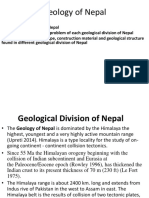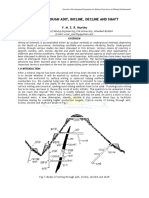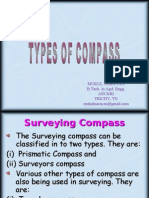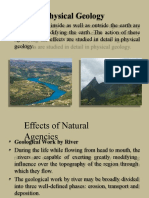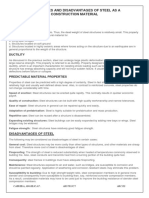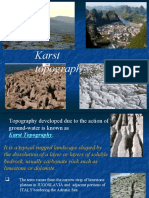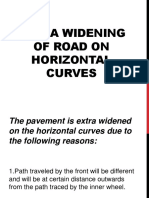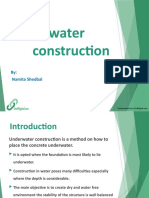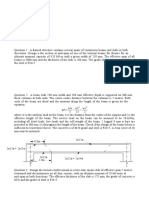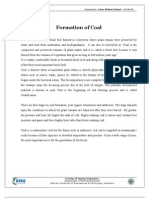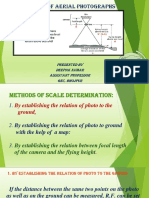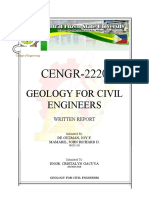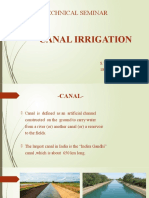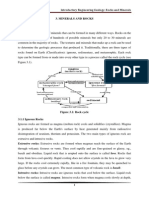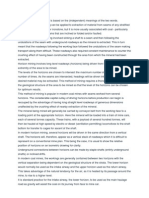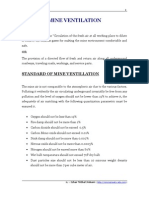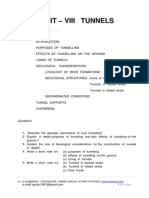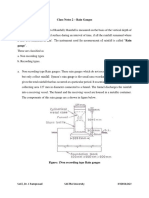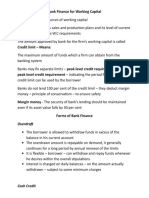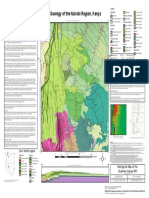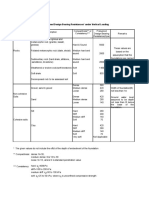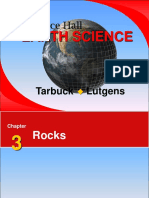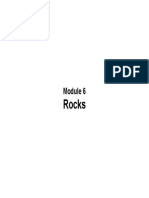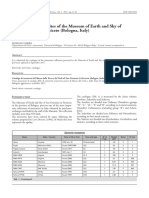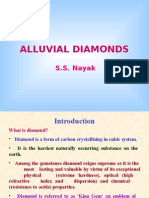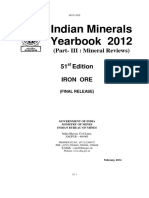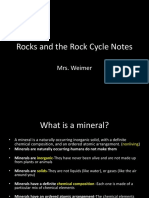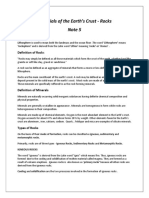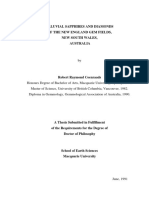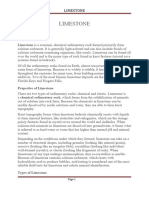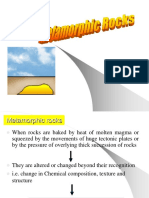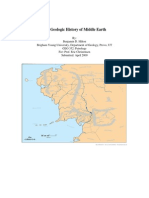Unit 8 Tunnels
Unit 8 Tunnels
Uploaded by
Prakash PatelCopyright:
Available Formats
Unit 8 Tunnels
Unit 8 Tunnels
Uploaded by
Prakash PatelOriginal Description:
Copyright
Available Formats
Share this document
Did you find this document useful?
Is this content inappropriate?
Copyright:
Available Formats
Unit 8 Tunnels
Unit 8 Tunnels
Uploaded by
Prakash PatelCopyright:
Available Formats
UNIT – VIII TUNNELS
CONTENTS………………………
INTRODUCTION
PURPOSES OF TUNNELLING
EFFECTS OF TUNNELLING ON THE GROUND
LINING OF TUNNELS
GEOLOGICAL CONSIDERATIONS
LITHOLOGY OF ROCK FORMATIONS
GEOLOGICAL STRUCTURES.. Joints at the tunnel site
Tunnels in faulted strata
Tunnels in folded strata
GROUNDWATER CONDITIONS
TUNNEL SUPPORTS
OVERBREAK
Questions:
1. Describe the geologic parameters of rock tunneling?
2. Explain in detail purposes of tunneling and also effects of tunneling on the
ground ?
3. Explain the role of Geological considerations for the construction of tunnels
in detail?
4. Write a brief note on: (a) purposes of tunneling
(b) effects of tunneling on the ground
(c) Lining in tunnels
5. Write a short note on: (a) Tunnels in faulted strata
(b) Tunnels in folded strata
(c) Over break
Dr G SUBBARAO, PROFESSOR, NNRES GROUP OF INSTITUTIONS || www.jntuworld.com
e-mail: gsrao1961@gmail.com 1|Page
Notes on Engineering Geology for III year B.Tech ( Civil )
………………compiled by Dr G.SUBBARAO M.Sc., M.Phil., Ph.D., C.S.M.
UNIT – VIII TUNNELS
Terminology
Tunnel: An underground passage for vehicles or pedestrians, especially one which is
created by digging into earth.
Axis: The lengthwise course of a tunnel, especially along the center line.
Cross section : The shape of a tunnel for eg: horseshoe, round or square.
Excavation: The process of digging or the hole which results.
Muck: Debris removed during excavation.
Grouting: Unstable rock and soil is strengthened by the injection of chemicals,
cementious materials .
Lining: Materials used to finish the inside surface of the tunnel.
Overburden : The soil and rock supported by the roof of a tunnel.
Portal: The open end of a tunnel. Usually includes a wall to retain the soil around the
opening.
Adit: Main entrance location of a tunnel
Profile: A side view of the tunnel.
Shaft: A vertical, underground passage from the top to the bottom where there is
initially no access to the bottom.
Tunnel Boring Machine (TBM): A tunneling machine which has cutting teeth at its front.
It creates the tunnel opening while passing the waste material through the rear.
Ventilation: Circulation of fresh air is called as ventilation.
Dr G SUBBARAO, PROFESSOR, NNRES GROUP OF INSTITUTIONS || www.jntuworld.com
e-mail: gsrao1961@gmail.com 2|Page
Tunnels are underground passages through hills or mountains used for several
operations. Tunnels are made by excavation of rocks below the surface or
through the hills.
Like other engineering structures, tunnels too need favourable geological
conditions at their sites for achieving success. In case of tunnels also, success
means safety, stability and economy.
To achieve these objectives, careful geological examinations should be made with
reference to the rock types occurring at the site ( lithology of rock-formations ),
structures associated with them and the prevailing ground water conditions.
The construction of underground tunnels, shafts and passageways are of course
essential but these are dangerous activities. Working under reduced light conditions,
limited access; the exposure to air contaminants and the hazards of fire and explosion,
underground construction workers face many dangers.
GEOTECHNICAL INVESTIGATIONS: A tunnel project must start with a comprehensive
investigation of ground conditions by collecting samples from boreholes and by other
geophysical techniques. Involvement of machinery and methods for excavation and
ground support, which will reduce the risk of encountering unforeseen ground conditions.
PURPOSES OF TUNNELLING: Tunnels are constructed for several operations:
In mining practice: Adits and shafts for reaching the work spots and for
the transport of workers and materials.
In certain mines: tunnels are made to extract coal from coal seams
In hydroelectric projects: Diversion tunnels for channel diversion ( by
diverting the normal flow of river water through the tunnels ) and for power
generation.
For water supply and sewage disposal: For supply of drinking water or
sewage disposal purposes, tunnels are made.
Transportation: to lay roads or railway tracks to regularize the traffic and
transportation of goods.
For laying cables and service lines: These are utility tunnels for laying
cables and for transport of oil/gas through pipelines.
To reduce the distance: To reduce the distance between places of interest
across natural obstacles like hills, to save time and to provide conveyance.
Dr G SUBBARAO, PROFESSOR, NNRES GROUP OF INSTITUTIONS || www.jntuworld.com
e-mail: gsrao1961@gmail.com 3|Page
Eg (1) In Bihar, between Hazaribagh and Gaya the eastern railway passes
through a number of tunnels across the hills of the Chota Nagapur
Plateau.
Eg (2) A number of tunnels of 1 km in length or less were driven in the
Deccan Traps between Bombay and Pune railway line.
Eg (3) In Jammu and Kashmir, 2 parallel tunnels of 2440 mts long were
made between Jammu and Srinagar in the Pir Panjal mountain range.
Eg (4): the under sea tunnels made between France and England and
between some islands of Japan.
CLASSIFICATION OF TUNNELS:
Depending on the nature & competency of the ground, tunnels are classified as:
Hard rock tunnels: The tunnel alignment is essentially through competent rock
mass with little or no ground water seepage.
Soft rock tunnels: The tunnel alignment is through unconsolidated or highly
weathered material which always encounter the groundwater problems.
EFFECTS OF TUNNELLING: When tunnels are made through weak or
unconsolidated formations, they are provided with suitable lining for safety and
stability. Lining may be in the form of steel structures or concrete.
Due to heavy and repeated blasting during excavation of a tunnel,
numerous cracks and fractures develop which reduces the compactness in
rocks. In addition, rock become loose/more fractured which allow water
movement .
Lining of the tunnel helps in checking the leakage of groundwater into the
tunnel.
Fault zones and shear zones are naturally weak and tunneling through
them further deteriorates and cause stability problem.
Fall of rocks takes place even in hard rocks like granite though devoid of
bedding or foliation and this process is known as Popping.
Roof may collapse due to stress and strain of the region due to overburden.
Poisonous gases encountered during the excavation of tunnels, sometimes.
ROAD TUNNELS IN INDIA:
Tunnel Length State Notes
Rohtang 8 820 m HP Under the 3978 above msl high Rohtang pass on Manali - Leh road
Dr G SUBBARAO, PROFESSOR, NNRES GROUP OF INSTITUTIONS || www.jntuworld.com
e-mail: gsrao1961@gmail.com 4|Page
Banihal 2 576 m JK Jammu - Kashmir road. 2209 m above sea level
Jawarhar 2 500 m JK Srinagar - Jammu
Kamshet-I 1 843 m MH Mumbai - Pune Expressway.
Bhatan 1 658 m MH Mumbai - Pune Expressway
Gokhale Nagar 1 000 m MH
Khambatki - Ghat 890 m MH
Madap 646 m MH Mumbai - Pune Expressway
Kamshet-II 359 m MH Mumbai - Pune Expressway
Khandala 330 m MH Mumbai - Pune Expressway.
Aodoshi ?m MH Mumbai - Pune Expressway. Only for Mumbai bound traffic
LINING OF TUNNELS: When tunnels are made through weak or loose or
unconsolidated formations, they are provided with suitable lining for safety and
stability. Lining may be in the form of steel structures or concrete.
The main purposes of lining are to resist the pressures from the surroundings
(from the roof or the sides or the floor) and to protect the shape of the tunnel.
Lining also helps in the leakage of ground water into the tunnel . Thus lining is a
an effective remedial measure to overcome the various drawbacks resulting from
underground tunneling either geologically or non-geologically.
Lining provides a regular shape to the tunnel as the excessive excavated
portions ( ie over break ) are filled by concrete. Lining being a very expensive
treatment, needs to be provided only at such places where the rocks are not
capable of supporting themselves,., where the rocks are weak and likely to
collapse.
Lining is also provided in such places where the seepage of water into the
tunnel occurs and creates problems. The zones of faulting or shearing also need
suitable lining to impart strength to them. Strong and complete lining is required
in hydropower tunnels which carry water under great pressure and even minor
leakages can prove hazardous.
Dr G SUBBARAO, PROFESSOR, NNRES GROUP OF INSTITUTIONS || www.jntuworld.com
e-mail: gsrao1961@gmail.com 5|Page
GEOLOGICAL CONSIDERATIONS: Geological considerations of tunneling
depend on various geological factors prevailing at the site. The geological
considerations in a civil engineering project (ie tunneling) include
Lithology of rock formations;
Geological Structures and
Groundwater conditions.
1. LITHOLOGY OF ROCK FORMATIONS : Massive Igneous rocks ( ie plutonic
and hypabyssal rocks ) are in general compact and competent and no lining is
required for the tunnels designed. Volcanic igneous rocks being often vesicular,
porous and permeable posses a threat of water seepage in the tunnel. However,
sometimes, the vesicular character is also competent and suitable for tunneling.
Eg: 20 tunnels were excavated for Bombay–Delhi railway line through amygdaloidal /
vesicular basalts.
Sedimentary rocks are less competent. However, sandstones with siliceous matrix
may be considered . If the sandstones have carbonate or iron oxide as cementing
material ( poorly cemented ), the tunnel lining needs reinforcement otherwise they
are undesirable.
Eg: In the Himalayan Ramganga diversion tunnel, a poorly cemented sandstone
formation, had caused a roof fall.
Limestones may expect seepage problems. Among limestones, dolomitic limestones
are harder and more durable. On the other hand, calcareous limestones or porous
limestones are naturally weaker, softer and are unsuitable for tunneling by virtue of
their tendency to corrode. Shales are the lest competent because of the clay
content. The presence of Clay layers are troublesome as they have low strength.
Among the metamorphic rocks, Quartzites and gneisses are massive and
competent. Phyllites and Schists are problematic due to the presence of foliation
and presence of susceptible minerals like mica and clay. Depending the
orientation of cleavage of minerals in case of slates may be considered. Marbles
are reasonably competent by virtue of their high compactness and granulose
structure.. But their susceptibility to corrosion and softness necessitates lining.
Dr G SUBBARAO, PROFESSOR, NNRES GROUP OF INSTITUTIONS || www.jntuworld.com
e-mail: gsrao1961@gmail.com 6|Page
GEOLOGICAL CONSIDERATIONS FOR EFFECTIVE TUNNELLING
Importance of Rock Types
SUITABILITY OF IGNEOUS ROCKS: Massive igneous rocks, i.e., the plutonic and
hypabyssal varieties, are very competent but difficult to work. They do not need any
lining or any special maintenance. This is so because they are very strong, tough, hard,
rigid, durable, impervious and, after tunneling, do not succumb to collapse, or to any
other deformation.
SUITABILITY OF SEDIMENTARY ROCKS: Thick bedded, well-cemented and siliceous
or ferruginous sandstones are more competent and better suited for tunneling. They will
be strong, easily workable and, moreover, do not require any lining. Thus they possess
all the desirable qualities for tunneling, provided they are not affected adversely by any
geological structures and ground water conditions.
Poorly cemented or argillaceous sandstones, however, are weak and undesirable,
particularly if they get saturated with water or are thin bedded. Shales, by virtue of their
inherent weakness and lamination, may get badly shattered during blasting. Mudstones
are weaker than shales as they are less compacted.
Among limestones, dolomitic limestones are harder and more durable. They are better
than other varieties. On the other hand, calcareous limestones or porous limestones are
naturally weaker and softer. Conglomerates need not be considered seriously due to the
presence of pebbles and unconsolidation.
Dr G SUBBARAO, PROFESSOR, NNRES GROUP OF INSTITUTIONS || www.jntuworld.com
e-mail: gsrao1961@gmail.com 7|Page
SUITABILITY OF METAMORPHICROCKS: Metamorphic rocks such as gneisses are
nearly similar to granites in terms of their competence, durability and workability. Schists,
Phyllites, etc., which are highly foliated and generally soft, are easily workable but
necessarily require good lining.
Quartzites are very hard and hence very difficult to work. Marbles are reasonably
competent by virtue of their high compactness and granulose structure. Slates are rather
soft and possess slaty cleavage. Hence they are weak and require lining.
(1) GEOLOGICAL STRUCTURES :
Strike and Dip orientation; Joints, Faults, Folds etc are the most common structural
features associated with rocks.
If the tunnel alignment coincides with the strike of the formations, is acceptable if
the formations are competent but in the case of less competent formations, the
tunnel alignment should be a short span.
(A) Joints at the tunnel site: Closely spaced joints in all kinds of rocks are harmful
( eg Koyna third stage tail tunnel has been excavated through a closely jointed
basalt causing roof fall with heavy copious leakage of water ). Joints which strike
parallel to the tunnel axis for long distances are undesirable whereas the joints
which are perpendicular to the tunnel axis have a limited effect.
In sedimentary rocks, the presence of joints may be due to folding ( occur along
crests and troughs ) or faulting is undesirable.
In metamorphic rocks, such as granite gneisses and quartzites are competent even
if the joints present due to their competent nature. Schists and Slates with joints
will become very incompetent and require lining.
(B) Tunnels in Faulted Strata: Faults are harmful and undesirable because of
the following problems:
Fault zones are places where the displacement of rocks occur and lead to
discontinuity in the tunnel alignment. The fault zones are places of intense
fracturing which means physical weakness in rock masses. Fault zones allow
percolation of groundwater which may cause for collapse of walls. Eg: Koyna
(Maharashtra state) third stage tunnel collapsed about 15 mts along a fault zone.
Fault zones are normally avoided along tunnel alignments. However, if they
cannot be avoided, the fault zone has to be extensively treated with concrete
grout and a strong lining has to be provided.
Problems are severe if the tunnel alignment coincides with the strike of the fault.
If the tunnel is located in the foot wall of a fault, the roof portion of the tunnel
Dr G SUBBARAO, PROFESSOR, NNRES GROUP OF INSTITUTIONS || www.jntuworld.com
e-mail: gsrao1961@gmail.com 8|Page
becomes instability and needs reinforcement. In case of Hanging wall, less effect
can be observed.
(C) Tunnels in Folded Strata: Folded rocks are always under considerable
strain. When excavation for tunnels are made in folded rocks, such rocks get the
opportunity to release the strain ( stored energy ). Such energy cause the rock
falls or bulging. In folded regions, the tunnel alignment may be advisable to have
the tunnel located on the limbs than at the core if possible.
Tunnel alignment parallel to the axis of a fold: This is desirable when tunneling
along limbs is considered. Rock masses may be in a highly fractured condition
along crests, hence there may be frequent fall of rocks from the roof. Tunnels
along troughs encounter harder formations and difficult to excavate. If bedding
planes are inclined, groundwater percolates and these aquifers are punctured
during the process of tunneling.
Tunnel alignment perpendicular to the axis of a fold: This is undesirable because
different rock formations are encountered along the length of the tunnel due to
heterogeneity in physical properties of rock.
In anticlinal fold, the central region will be under lesser pressure when compared
to synclinal fold where the central region will be under higher pressure in addition
to the occurrence of ground water.
However, anticlinal fold is to be considered for tunneling with proper precautions.
TUNNELS PERPENDICULAR TO THE AXIS OF FOLD
L
Lesser Higher
pressure pressure
Dr G SUBBARAO, PROFESSOR, NNRES GROUP OF INSTITUTIONS || www.jntuworld.com
e-mail: gsrao1961@gmail.com 9|Page
(2) GROUNDWATER CONDITIONS: Ground water problem in the tunneling is
the most serious one. If ground water encountered in case of tunneling, the entire
water is to be pumped out to keep the working area dry and adds the
expenditure on tunneling project.
If the water table lies below the level of the tunnel, no severe ground water
problem can be anticipated. But if the tunnel lies below the position of the water
table , then the ground water problem is inevitable. .
TUNNEL SUPPORTS : Supports are used for keeping the tunnel walls and the
roof in safety condition. Several support alternatives are available for use in
tunnels. Following are the types of supports:
Shotcrete : Shotcrete is mortar or concrete pneumatically sprayed at high velocity
through a hose. The process can be a dry process ( Guniting ) or a wet process.
Rock Bolts: These are steel bolts designed for holding weak formations
together. The bolts are driven into the formations without causing any disturbance.
These are used in tunneling for anchoring the tunnel walls to sold rock.
Wire mesh; Concrete lining; Pre-stressed anchor cables; Steel ribs etc are
also used wherever is necessary.
Some of these types are used in combination also.
OVERBREAK: Excavations through hard rocks involves the removal of some
of the rocks outside the proposed perimeter of the tunnel.
The quantity of rock removed, in excess of what is required by the perimeter of
the proposed tunnel, is known as the over break.
The geological factors which govern the amount of over break are:
The nature of the rocks
The orientation and spacing of joints or weak zones
The orientation of the bedding planes in case sedimentary rocks.
In general, tunnels which pass through a single homogeneous formation without
structural defects produce little over break, whereas tunnels which pass through a
variety of rocks with structural defects ( like fault zones ) have more over break.
The factor of over break is important because it adds to the cost of tunneling,
particularly if lining is required. Hence, it is desirable that over break should be as
minimum as possible.
Dr G SUBBARAO, PROFESSOR, NNRES GROUP OF INSTITUTIONS || www.jntuworld.com
e-mail: gsrao1961@gmail.com 10 | P a g e
Bumping ground Rock displacement and dislodging in tunneling rocks
Circular shape tunnel Is adopted in case of diversion of water at dam site
Discharge tunnels Tunnels are those which are meant for conveying water
from one point to another under gravity force.
Diversion tunnels By diverting the normal flow of river water through the
tunnels dug along the valley sides
Fan cut blasting means To get more face for the excavation of rocks
Hokoriku railway tunnel in Is 13.87 km through sandstones and granites.
Japan
Horse shoe shape tunnel; Is adopted for old tunnel excavations
Joints oblique or perpen- Are obviously have a limited effect
dicular to the tunnel axis
Joints which are parallel to Are undesirable in all kinds of rocks.
the tunnel axis
OVER BREAK The qty of rock broken and removed in excess of what is
required by the perimeter of the proposed tunnel.
Parallel hole cut blasting Blast holes are placed parallel to each other with a
means RELIEF HOLE of a larger dimension
Popping effect in tunneling It refers to the phenomenon of fall of rocks which takes
place in hard rocks like granite devoid of bedding or
foliation.
Pressure tunnels Tunnels are those which are used to allow water to
pass through them under force. Used for power
generation
Purpose of lining Lining refers to the support for the tunnel.
Rock Bursts means These occur at great depths with enormous overburden
pressure
Smooth blasting means Small holes are placed along the circumference of
blasting area
Suitability of shales Faster progress but proper lining is necessary
Suitability of gneisses & Good in all aspects for tunneling
quartzites
Suitability of Limestone & Durable for tunneling purpose
dolomitic limestones
Suitability of Mudstones Weaker than shales and undesirable for tunneling.
Suitability of schists & In competent but require lining for tunneling
Phyllites
Suitability of Conglomerates Undesirable rocks
for tunneling
Suitability of igneous rocks Very competent and lining is required
Suitability of well-cemented Better suited for tunneling
siliceous sandstone
RQD means Rock Quality Designation means the ratio of cumulative
length of rock pieces expressed as a percentage of total
length of the rock
RSR RSR means the rating of the quality of a rock for tunnel
support recommendations.
Dr G SUBBARAO, PROFESSOR, NNRES GROUP OF INSTITUTIONS || www.jntuworld.com
e-mail: gsrao1961@gmail.com 11 | P a g e
You might also like
- IIT JAM Geology: Preparation Tips, Books, Study Materials!Document13 pagesIIT JAM Geology: Preparation Tips, Books, Study Materials!Kadamb Sachdeva100% (1)
- Lecture 9 - Geology of Nepal HimalayaDocument22 pagesLecture 9 - Geology of Nepal HimalayaBEENAYEK AdHIKARI100% (2)
- 1mining Through Adit, Incline, Decline and ShaftDocument11 pages1mining Through Adit, Incline, Decline and ShaftAkhil Sai KrishnaNo ratings yet
- Geological Considerations in TunnellingDocument8 pagesGeological Considerations in Tunnellingpaul macharia100% (1)
- Cenozoic Stratigraphy of IndiaDocument51 pagesCenozoic Stratigraphy of IndiaGirijesh Pandey0% (1)
- Compass Types in SurveyingDocument12 pagesCompass Types in SurveyingMukul Narayan100% (9)
- Lec - II Geological Action of RiverDocument42 pagesLec - II Geological Action of RiverYogendra Patil100% (1)
- Classification of SurveyingDocument53 pagesClassification of SurveyingMohammed Ajmalkhan100% (1)
- Geological Work of RiverDocument14 pagesGeological Work of RiverBEN50% (2)
- Tunnel and Road CuttingDocument20 pagesTunnel and Road CuttingKaren DarilaNo ratings yet
- DESIGN CONCEPTS OF SUBSTRUCTURES FDocument22 pagesDESIGN CONCEPTS OF SUBSTRUCTURES FsyedNo ratings yet
- Monocable Ropeway SystemDocument17 pagesMonocable Ropeway Systemsudishett100% (2)
- Chapter 2 - Prismatic Compass SurveyingDocument32 pagesChapter 2 - Prismatic Compass Surveyingamin100% (3)
- Petrofabrics: Petrofabric AnalysisDocument1 pagePetrofabrics: Petrofabric AnalysisD DNo ratings yet
- Advantages and Disadvantages of Steel As A ConstructionDocument2 pagesAdvantages and Disadvantages of Steel As A ConstructionAngel Cabrera100% (1)
- Soil ExplorationDocument127 pagesSoil ExplorationRakesh ReddyNo ratings yet
- Road PatternsDocument3 pagesRoad PatternsMubasheer KNo ratings yet
- Karst TopographyDocument12 pagesKarst TopographychatterjeevaiNo ratings yet
- Quantity Surveying & Cost Estimation CE-372 XEN Shahid HussainDocument4 pagesQuantity Surveying & Cost Estimation CE-372 XEN Shahid HussainAli TariqNo ratings yet
- Classification of Rocks Lecture-3Document20 pagesClassification of Rocks Lecture-3Dr. Daljeet Singh Sidhu100% (1)
- Geology in Brdge ConstructionDocument10 pagesGeology in Brdge Constructionbharasha mahantaNo ratings yet
- Methods of MeasurementDocument10 pagesMethods of Measurementanon_633165161No ratings yet
- 300+ TOP ENGINEERING GEOLOGY Lab Viva Questions and Answers3Document39 pages300+ TOP ENGINEERING GEOLOGY Lab Viva Questions and Answers3Oluseyi AbegundeNo ratings yet
- Extra Widening of Road On Horizontal CurvesDocument16 pagesExtra Widening of Road On Horizontal CurvesKim Junmyeon50% (2)
- Question Bank - RCCDocument5 pagesQuestion Bank - RCCjeevanreddyvkNo ratings yet
- Wire RopesDocument24 pagesWire RopesSilent Tornado100% (1)
- Typical Cross SectionsDocument12 pagesTypical Cross Sectionsbinodpa75% (4)
- Underwater ConstructionDocument11 pagesUnderwater ConstructionSwaraj Gaikwad100% (2)
- CurvesDocument118 pagesCurvesAmitabha ChakrabortyNo ratings yet
- 1application & Objectives of Rock MechanicsDocument25 pages1application & Objectives of Rock MechanicsSheshu Babu100% (4)
- 8.3 - Safety On Hill RoadsDocument109 pages8.3 - Safety On Hill RoadsShashikant VermaNo ratings yet
- Numericals On RCC DESIGNDocument10 pagesNumericals On RCC DESIGNsirfmein50% (2)
- 1-Darcy's LawDocument25 pages1-Darcy's LawDarya MemonNo ratings yet
- Geology in Civil EngineeringDocument108 pagesGeology in Civil EngineeringKnowell Jan PartozaNo ratings yet
- Formation of Coal & Theories Associated With Coal FormationDocument2 pagesFormation of Coal & Theories Associated With Coal FormationIzhar Jiskani100% (2)
- Be Mining Geology - 1 NotesDocument158 pagesBe Mining Geology - 1 Notesvarun0% (1)
- Differences Between Residual and Transported SoilsDocument4 pagesDifferences Between Residual and Transported SoilsRajesh KhadkaNo ratings yet
- M4 (L-7) Numerical Problems On PhotogrammetryDocument27 pagesM4 (L-7) Numerical Problems On PhotogrammetryRajiv KumarNo ratings yet
- Notes Unit 1Document23 pagesNotes Unit 1div300482No ratings yet
- Cross Sectional Elements of A RoadDocument16 pagesCross Sectional Elements of A RoadRamanarayanSankritiNo ratings yet
- Geology For Civil EngineersDocument4 pagesGeology For Civil EngineersMr. DummyNo ratings yet
- Lesson 10 Steady Groundwater Flow To WellsDocument27 pagesLesson 10 Steady Groundwater Flow To WellsRajesh Khadka100% (1)
- Canal IrrigationDocument15 pagesCanal IrrigationVamshi SonnayelaNo ratings yet
- Tunneling in Soft GroundDocument22 pagesTunneling in Soft GroundAnkit Kumar100% (1)
- Chapter-Ii Types of FoundationsDocument61 pagesChapter-Ii Types of FoundationsVijaykumar Nagnaik100% (1)
- Tunneling in Soft and Hard Strata Part 5Document152 pagesTunneling in Soft and Hard Strata Part 5tagavi9129No ratings yet
- Minerals and Rocks Lecture NotesDocument22 pagesMinerals and Rocks Lecture NotesOyedotun Tunde67% (3)
- Engineering Considerations in Folds, Faults, and JointsDocument2 pagesEngineering Considerations in Folds, Faults, and JointsSlasher FloresNo ratings yet
- Horizon MiningDocument2 pagesHorizon MiningVidya SagarNo ratings yet
- Aquifer and Its TypesDocument13 pagesAquifer and Its TypesAnagha mohan0% (1)
- Zojila Tunnel Project LadakhDocument16 pagesZojila Tunnel Project LadakhRinchen Tundup100% (1)
- Mine VentilationDocument3 pagesMine VentilationIzhar Jiskani100% (2)
- Types of EarthdamsDocument21 pagesTypes of EarthdamsDilipKumarAkkaladeviNo ratings yet
- Chain SurveyingDocument24 pagesChain SurveyingSherly JamesNo ratings yet
- Engineering Geology LabDocument53 pagesEngineering Geology LabChandra Sekhar100% (1)
- Topic 6 - Core BoringDocument2 pagesTopic 6 - Core BoringHikaruNo ratings yet
- Unit 8 TunnelsDocument11 pagesUnit 8 TunnelsEashan AdilNo ratings yet
- Eg Unit 5Document20 pagesEg Unit 5Shifranth VarmaNo ratings yet
- A Review Study On Methods of Tunneling I PDFDocument5 pagesA Review Study On Methods of Tunneling I PDFpaNo ratings yet
- TunnelsDocument10 pagesTunnelsRonit ChariNo ratings yet
- Class Note 2 - Rain GaugesDocument6 pagesClass Note 2 - Rain GaugesPrakash PatelNo ratings yet
- Unit 1Document60 pagesUnit 1Prakash PatelNo ratings yet
- Metro CivilDocument66 pagesMetro CivilPrakash Patel100% (2)
- ILD Short AnswersDocument6 pagesILD Short AnswersPrakash PatelNo ratings yet
- Bank Finance For Working Capital - E&MDocument5 pagesBank Finance For Working Capital - E&MPrakash PatelNo ratings yet
- Inside Our EarthDocument3 pagesInside Our EarthAli Imran NaqviNo ratings yet
- 1 Proceedings BESA2012 Page1 84Document84 pages1 Proceedings BESA2012 Page1 84bayu sungkonoNo ratings yet
- Geology of The Nairobi Region, Kenya PDFDocument1 pageGeology of The Nairobi Region, Kenya PDFKevin RotichNo ratings yet
- Weimer 1982Document13 pagesWeimer 1982Rus Lin Machaca CallizayaNo ratings yet
- Breksi DiatremaDocument6 pagesBreksi DiatremaMuhammad HidayatNo ratings yet
- Petrology of Igneous RockDocument16 pagesPetrology of Igneous RockNurul HusnaNo ratings yet
- Geologic ProcessesDocument37 pagesGeologic ProcessesMaricar Vecinal Magnaye100% (1)
- Table 6.3 Presumed Design Bearing Resistances Under Vertical LoadingDocument1 pageTable 6.3 Presumed Design Bearing Resistances Under Vertical LoadingesmailNo ratings yet
- Prentice Hall: Earth ScienceDocument36 pagesPrentice Hall: Earth ScienceNur-aine Londa HajijulNo ratings yet
- Jeffrey's Job. GeologiaDocument16 pagesJeffrey's Job. GeologiaJEFFREY JAIROSSE JONo ratings yet
- Notes For Bulacan FieldworkDocument2 pagesNotes For Bulacan FieldworkRuu ChinNo ratings yet
- Module 6 RockDocument12 pagesModule 6 RockAnggi RonsumbreNo ratings yet
- Topic 11 Rocks Minerals NotesDocument58 pagesTopic 11 Rocks Minerals Noteseyren fallorNo ratings yet
- Halpern (1973)Document16 pagesHalpern (1973)Gabriel GonzálezNo ratings yet
- Iugs043 01 06Document21 pagesIugs043 01 06Geologians DUNo ratings yet
- 11-32 SerraDocument22 pages11-32 Serradjettaou ahmedNo ratings yet
- Mungall, J. E. (2014) - Geochemistry of Magmatic Ore Deposits. Treatise On Geochemistry PDFDocument24 pagesMungall, J. E. (2014) - Geochemistry of Magmatic Ore Deposits. Treatise On Geochemistry PDFofiol75No ratings yet
- Ore Geology Reviews: SciencedirectDocument23 pagesOre Geology Reviews: SciencedirectjfsilvaNo ratings yet
- MDMW Diamond06Document48 pagesMDMW Diamond06miningnova50% (2)
- 07092014125520IMYB - 2012 - Iron Ore PDFDocument35 pages07092014125520IMYB - 2012 - Iron Ore PDFc_b_umashankarNo ratings yet
- Rocks and The Rock Cycle Notes: Mrs. WeimerDocument43 pagesRocks and The Rock Cycle Notes: Mrs. WeimerFonfo LawrenceNo ratings yet
- Materials of The Earth's Crust - Rocks Note 5Document3 pagesMaterials of The Earth's Crust - Rocks Note 5subhaseduNo ratings yet
- 1991 - Coenraads R. - Australian Aluvial Sapphires and Diamons - Thesis - PHD PDFDocument299 pages1991 - Coenraads R. - Australian Aluvial Sapphires and Diamons - Thesis - PHD PDFevamatisNo ratings yet
- Chapter - 1 StonesDocument5 pagesChapter - 1 StonesLalith Koushik Ganganapalli100% (1)
- What Is LimestoneDocument3 pagesWhat Is Limestonefeugueng john francis kingNo ratings yet
- LimestoneDocument8 pagesLimestoneMatthew RamlochanNo ratings yet
- Metamophic RockDocument28 pagesMetamophic RockkarbubNo ratings yet
- Geology PPT RecoveredDocument85 pagesGeology PPT Recovered8 SQUADNo ratings yet
- Intrusive RocksDocument2 pagesIntrusive Rocksanon_114803412No ratings yet
- Geology of Middle EarthDocument10 pagesGeology of Middle Earthshawn_gaffneyNo ratings yet

